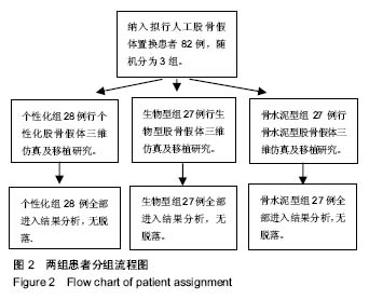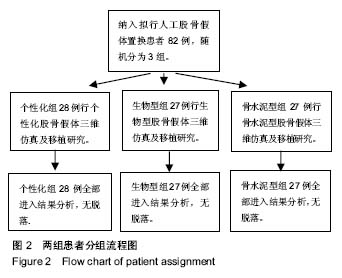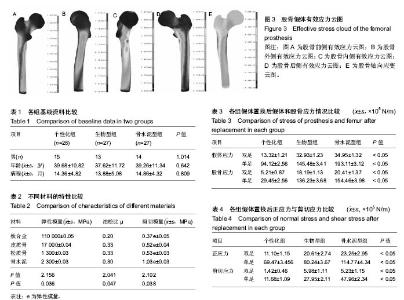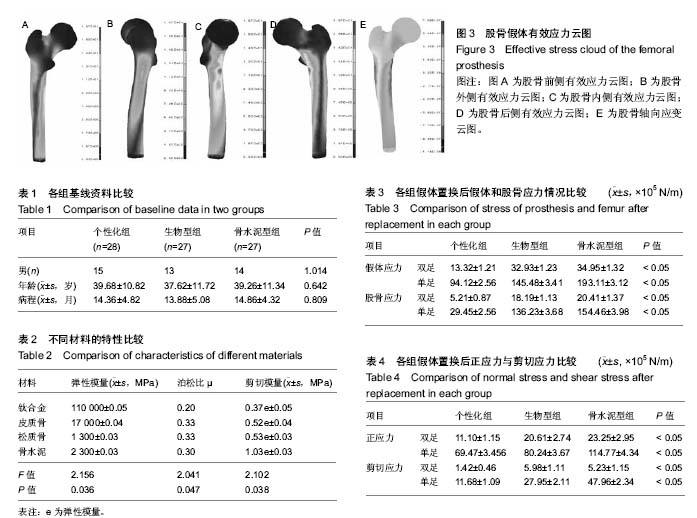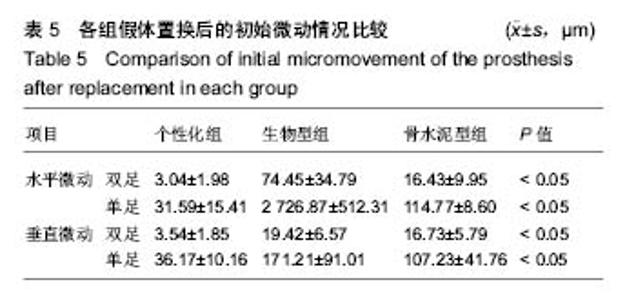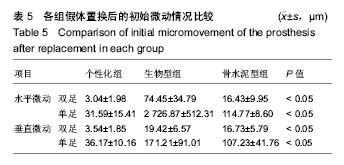| [1] Wu ES, Jauregui JJ, Baneqee S, et al. Outcomes of delayed total hip arthroplasty in patients with a previous ipsilateral acetabular fracture. Expert Rev Med Devices. 2015;12(3):297-306.[2] 王沫楠,李鹏程,付宜利,等.股骨假体结构与材料性能分析及多目标优化[J].哈尔滨工业大学学报,2016,48(7):20-26.[3] 孙振辉,李楠,辛景义,等.测号器确定全膝关节置换股骨假体型号与前髁内侧悬出状态的意义[J].中华医学杂志, 2016,96(47):3811-3814.[4] 朱旭日,孙光权,刘锌,等.高龄骨质疏松陈旧性股骨颈骨折:应根据股骨距-髓腔比率选择股骨假体[J].中国组织工程研究, 2015,19(17):2631-2636.[5] Bozic KJ,Grosso LM,Lin Z,et al.Variation in hospital-level risk standardized complication rates following elective primary total hip and knee arthroplasty.J Bone Joint Surg Am. 2014;96(8):640-647.[6] 朱永生,徐耀增,朱锋,等.Accolade TMZF生物型股骨假体用于全髋置换的早期随访[J].中国组织工程研究, 2015,19(17):2637-2641.[7] 朱月新,张海涛,牛志勇,等.髋关节置换术后股骨假体周围骨折的病因分析及疗效探讨[J].实用临床医药杂志, 2016,20(23):164-166.[8] 王金良,骆晓飞,魏瑄,等.更换长柄股骨假体结合内固定治疗假体松动型股骨假体周围骨折[J].中华创伤骨科杂志, 2016,18(2):169-171.[9] 孙强,鲁尧,王洪勋,等.改良记忆合金环抱器治疗髋关节置换术后股骨假体周围骨折的生物力学研究[J].中华创伤杂志, 2015,31(7):637-640.[10] 胡杨,董跃福,徐卿荣,等.全膝关节置换股骨假体植入定位参数有限元分析及优化[J]. 临床骨科杂志,2012,15(3):334-338.[11] 陈善斌,刘智.骨水泥与生物型股骨假体治疗老年股骨颈骨折的临床疗效比较[J].中国骨伤,2016,29(11):977-981.[12] 都斌,王勇,蒋建农,等.生物型全涂层股骨长柄假体治疗Vancouver B2型股骨假体周围骨折[J].中华创伤杂志, 2015,31(8):709-713.[13] 朱月新,韩凤申,张海涛,等.髋关节置换术中股骨假体周围骨折的临床影响因素分析[J].中国医药导刊,2017,19(1):53-54.[14] 沈长青.髋关节置换术前后股骨假体周围骨密度变化与近期疗效的关系[J].山东医药,2016,56(32):61-63.[15] 储小兵,吴海山,徐长明,等.全膝关节置换术中股骨假体旋转对髌股关节生物力学影响的实验研究[J]. 中华外科杂志, 2006,44(16):1136-1140.[16] 杨二平,彭昊,杜远立,等.非骨水泥长柄股骨假体治疗Vancouver B型股骨假体周围骨折[J].海南医学,2016,27(9):1436-1438.[17] 刁乃成,郭艾,杨波,等.人工髋关节置换术中股骨假体周围骨折的危险因素分析[J].北京医学,2015,37(11):1025-1027.[18] 秦菲菲,刘雨,贾艳辉,等.全髋关节置换术后股骨假体周围骨折的围手术期护理[J].护理实践与研究,2016,13(9):44-47.[19] 刘青,张宇,乔辉,等.依据标准化数字X线模板预测股骨假体型号的可行性[J].中华骨科杂志,2016,36(15):964-973.[20] 洪嵩,林佳生,周勇,等.远端稳定型股骨假体治疗青壮年股骨近端骨折合并不可逆转髋关节疾患疗效评估[J].四川大学学报(医学版),2016,47(4): 565-569.[21] 王桂峰,王小林,杜伟,等.老年股骨颈骨折生物型人工髋关节置换术后股骨假体周围骨密度的变化[J].中国老年学杂志, 2015,35(17):4941-4942.[22] Borg T, Hailer NP. Outcome 5 years after surgical treatment of acetabular fractures: a prospective clinical and radiographic follow up of 101patients. Arch Orthop Trauma Surg. 2015;135(2):227-233.[23] 莫富灏,杜敏,刘傥,等.肿瘤型膝关节置换后股骨-假体-胫骨复合体生物力学响应[J].医用生物力学,2016,31(3):235-239,246.[24] 高益,瞿玉兴,王斌,等.全髋关节置换术后单用与联合应用抗骨质疏松药物的疗效对比研究[J].中国现代医学杂志, 2016,26(23):82-88.[25] 许杨,凌义龙,韦金忠,等.长柄全涂层表面微孔股骨假体在人工全髋关节翻修术中的应用[J].中医正骨,2016,28(9):49-51.[26] 吴国锋,孙晓亮,周剑,等.短柄股骨假体在年轻类风湿性关节炎患者关节置换术中的应用[J].实用骨科杂志,2016,22(2):115-118.[27] Makridis KG, Obakponovwe O, Bobak P, et al. Total hiparthroplasty after acetabular fracture: incidence of complications, reoperation rates and functional outcomes: evidence today. J Arthroplasty. 2014;29(10):1983-1990.[28] 唐江安,杨铁毅,王思辉,等.人工髋关节置换术后股骨假体周围骨折的分类方法及治疗[J].临床和实验医学杂志, 2016,15(20):2032-2034.[29] 张加勇,尚希福,贺瑞,等.TKA 术后股骨假体旋转对 KSS 主观评分影响的临床研究[J].实用骨科杂志, 2016,22(9):788-790,809.[30] 张旭辉,夏磊,王刚涛,等.关节翻修治疗全髋关节置换术后VancouverB2、B3型股骨假体周围骨折[J].中国骨与关节损伤杂志,2015,30(12): 1303-1304.[31] 鲁宁,杨阳,李伟强,等.骨水泥长柄假体结合钛缆固定治疗老年Vancouver B2型股骨假体周围骨折[J].中国骨与关节损伤杂志, 2016,31(12): 1294-1295.[32] 许广达,郭荣光,金舒,等.髋关节置换术股骨假体周围骨折的手术治疗[J].中国骨与关节损伤杂志,2016,31(10):1068-1069.[33] 钟航,杨静,裴福兴,等.皮质骨板联合髁钢板治疗全膝置换术后股骨假体周围骨折[J].实用骨科杂志,2016,22(3):225-228.[34] 吕信息,杨晓秋,田智勇,等.手术治疗VancouverB1型股骨假体周围骨折疗效观察[J].贵州医药,2015,39(12):1096-1098.[35] 董巍,刘创建,张天一,等.基于有限元法的Vancouver B1型股骨假体周围骨折内固定力学分析[J].第二军医大学学报, 2017,38(2):253-257.[36] 闵重函,张洪美,周瑛,等.人工髋关节翻修的股骨假体柄的形态及稳定性的临床观察[J].中国骨伤,2015,28(3):205-209.[37] 吴鹏,陈雷,郎俊哲,等.人工全膝关节置换术股骨假体矢状位位置的影响因素[J].中国骨伤,2016,29(4):340-344.[38] 郭涛,张亚奎,张星火,等.人工髋关节置换术发生股骨假体周围骨折的影响因素分析[J].现代生物医学进展, 2016,16(9):1731-1733.[39] 陈骁,金毅,程旭光,等.人工髋关节置换术后股骨假体周围骨折治疗[J].中华实用诊断与治疗杂志,2015,29(12):1218-1219,1222.[40] 袁玉林,王臻,张浩强,等.新型非骨水泥柄设计特征及临床应用效果[J].现代生物医学进展,2016,16(18):3464-3468,3518.[41] 佟刚,赵鉴非,戴军,等.Wagner SL股骨假体治疗复杂股骨近端骨折的疗效观察[J].中国骨与关节损伤杂志,2016,31(4):356-358. |
